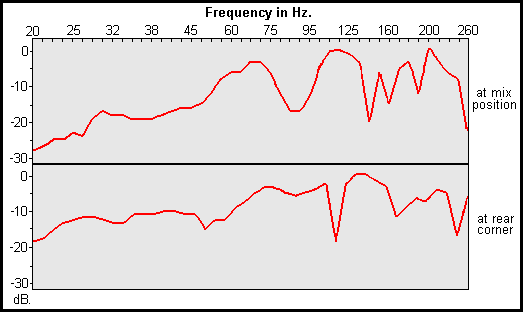Ethan,
Yeah, my last "shutting off the conversation" comment wasn't too cool. I must have had a hard day in the clean room that day.

I agree that a 1/3 octave measurement might not give enough detail to be very useful in room design, but this is no fundamental limitation of noise based measurements. A sine wave measurement using a tunable 1/3 octave analyzer would have the same lack of resolution. Remember that sine waves can also excite nearby resonances to some degree, so this measurement would also yield the signal integrated under the 1/3 octave peak.
Furthermore, Alex isn't using a 1/3 octave analyzer. He's recording a waveform then putting it thought a Fast Fourier Transform. The frequency resolution depends on the smoothing window and such, but I'm sure that it's much finer than 1/3 octave.
Here's an example that shows how an impulse measurement can yield the same interference information as a sine wave measurement.
We simulate an omni directional source 0.5m away from a large 100% reflective wall. The test microphone is 10m away from the source as shown. The source produces a short pulse. The waveform below illustrates the original pulse plus it's reflection from the wall. The reflection is phase inverted. Its amplitude is also diminished by -1.66dB due to the extra meter it needed to travel.
If we Fourier transform the original pulse we get the results in the first spectral graph. The short pulse has a broad, flat low frequency spectrum flowed by higher frequency ripples. This is simply the characteristic spectrum of this particular pulse. A different shaped pulse would have a different characteristic spectrum.
Now comes the interesting part. Now we Fourier transform the entire waveform - the original pulse plus the reflection. The last spectral graph shows the result. What we see is a comb filter superimposed on the characteristic pulse spectrum. The first response dip occurs at 344Hz which has a 1m wavelength corresponding the 1m path length difference between the direct and reflected signal. This is the exact same comb filter effect we would expect to see using steady state sine wave signals. Had we used a shorter pulse with an even broader frequency spectrum there would be no difference at all between the pulse/reflection response and a sine wave response.
[The low frequency roll off in the pulse/reflection spectrum probably has something to do with data windowing and sample size. I'm not an expert on these details of FFT, but I know these sorts of things can be accounted for.]
Alex,
You should definitely use a small omni microphone for this measurement. Also it’s a good idea to record several seconds worth of data for good signal to noise ratio. Then fade the beginning and ending 0.5 seconds of the recording to zero. Analyze the whole waveform including the fades. This will help eliminate high and low frequency anomalies associated with truncating the waveform.
Thomas

